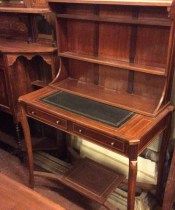featured item
antique pair florentine rococo giltwood mirrors 19th century 102x63cm

antiques available from other sellers in antiques miscellaneous > unclassified
-
![Unusual Inlaid Edwardian Mahogany Desk]() £550.00
£550.00unusual inlaid edwardian mahogany desk Read more
Victoria Antiques Cornwall -
![18th Century Oak Trunk]() £450.00
£450.0018th century oak trunk Read more
Victoria Antiques Cornwall -
![Nice Edwardian Armchair Inlaid in Green Velvet]() £195.00
£195.00nice edwardian armchair inlaid in green velvet Read more
Victoria Antiques Cornwall -
![Nice Edwardian Sofa Inlaid in Green Velvet]() £230.00
£230.00nice edwardian sofa inlaid in green velvet Read more
Victoria Antiques Cornwall
- View other items in:
- antiques miscellaneous
Still not found something similar? Why not save a search and get a notification in your inbox when an matching antique is added to our ever-growing database?
Enter your email address to be sent alerts when new items are added to the site that match your search criteria

This is a superb pair of antique Italian Florentine giltwoodmirrors, circa 1870 in date.
This impressive pair is certain to make a charming addition to that one special room in your home.
Our reference: A2578
Rococo
Although Rococo is usually thought of as developing first in the decorative arts and interior design, its origins lie in the late Baroque architectural work ofBorromini(1599–1667) mostly in Rome andGuarini(1624–1683) mostly in Northern Italy but also in Vienna, Prague, Lisbon, and Paris. Italian architects of the late Baroque/early Rococo were wooed to Catholic (Southern) Germany,Bohemiaand Austria by local princes, bishops and prince-bishops. Inspired by their example, regional families of Central European builders went further, creating churches and palaces that took the local German Baroque style to the greatest heights of Rococo elaboration and sensation.
An exotic but in some ways more formal type of Rococo appeared in France whereLouis XIV's succession brought a change in the court artists and general artistic fashion. By the end of the king's long reign, rich Baroque designs were giving way to lighter elements with more curves and natural patterns. These elements are obvious in the architectural designs ofNicolas Pineau. During theRégence, court life moved away fromVersaillesand this artistic change became well established, first in the royal palace and then throughout French high society.
The delicacy and playfulness of Rococo designs is often seen as perfectly in tune with the excesses of Louis XV's reign.
Antiques.co.uk Ref: CDW6B9FRR
- Width (cm):
- 63
- Height (cm):
- 102
- Depth (cm):
- 4
Here on antiques co uk we love antiques and specialise in selling antiques. Even though this item was for sale and is now sold or otherwise now unavailable we have many more items for sale including vintage antiques, silver, tables, watches, jewellery and much more for your interiors and home.
Search all the antiques currently for sale on www.antiques co uk. Or why not consider selling your antiques and making sales more easily with us!
regent antiques limited
Regent Antiques Limited has 986 antiques for sale.
click here to see them all










